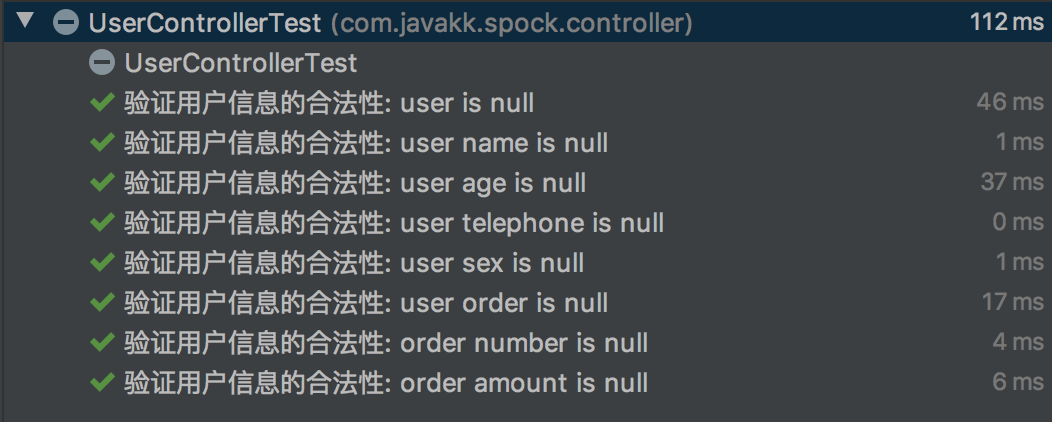这是Spock系列的第五篇文章,这一篇主要讲使用Spock如何测试代码中抛异常的场景
背景
有些方法需要抛出异常来中断或控制流程,比如参数校验的逻辑: 不能为null,不符合指定的类型,list不能为空等验证,如果校验不通过则抛出checked异常,这个异常一般都是我们封装的业务异常信息,比如下面的业务代码:
/**
* 校验请求参数user是否合法
* @param user
* @throws APIException
*/
public void validateUser(UserVO user) throws APIException {
if(user == null){
throw new APIException("10001", "user is null");
}
if(null == user.getName() || "".equals(user.getName())){
throw new APIException("10002", "user name is null");
}
if(user.getAge() == 0){
throw new APIException("10003", "user age is null");
}
if(null == user.getTelephone() || "".equals(user.getTelephone())){
throw new APIException("10004", "user telephone is null");
}
if(null == user.getSex() || "".equals(user.getSex())){
throw new APIException("10005", "user sex is null");
}
if(null == user.getUserOrders() || user.getUserOrders().size() <= 0){
throw new APIException("10006", "user order is null");
}
for(OrderVO order : user.getUserOrders()) {
if (null == order.getOrderNum() || "".equals(order.getOrderNum())) {
throw new APIException("10007", "order number is null");
}
if (null == order.getAmount()) {
throw new APIException("10008", "order amount is null");
}
}
}APIException是我们封装的业务异常,主要包含errorCode,errorMessage属性:
/**
* 自定义业务异常
*/
public class APIException extends RuntimeException {
private String errorCode;
private String errorMessage;
setXXX...
getXXX...
}这个大家应该都很熟悉,针对这种抛出多个不同错误码和错误信息的异常,如果我们使用Junit的方式测试,会比较麻烦,就目前我使用过的方法,如果是单个异常还好,多个的就不太好写测试代码
最常见的写法可能是下面这样:
@Test
public void testException() {
UserVO user = null;
try {
validateUser(user);
} catch (APIException e) {
assertThat(e.getErrorCode(), "10001");
assertThat(e.getErrorMessage(), "user is null");
}
UserVO user = new UserVO();
try {
validateUser(user);
} catch (APIException e) {
assertThat(e.getErrorCode(), "10002");
assertThat(e.getErrorMessage(), "user name is null");
}
...
}当然可以使用junit的ExpectedException方式:
@Rule
public ExpectedException exception = ExpectedException.none();
exception.expect(APIException.class); // 验证抛出异常的类型是否符合预期
exception.expectMessage("Order Flight return null exception"); //验证抛出异常的错误信息或者使用@Test(expected = APIException.class) 注解
但这两种方式都有缺陷:
@Test方式不能指定断言的异常属性,比如errorCode,errorMessage
ExpectedException的方式也只提供了expectMessage的api,对自定义的errorCode不支持,尤其像上面的有很多分支抛出多种不同异常码的情况
thrown
我们来看下Spock是如何解决的,Spock内置thrown()方法,可以捕获调用业务代码抛出的预期异常并验证,再结合where表格的功能,可以很方便的覆盖多种自定义业务异常,代码如下:
/**
* 校验用户请求参数的测试类
* @author 公众号:Java老K
* 个人博客:www.javakk.com
*/
class UserControllerTest extends Specification {
def userController = new UserController()
@Unroll
def "验证用户信息的合法性: #expectedMessage"() {
when: "调用校验用户方法"
userController.validateUser(user)
then: "捕获异常并设置需要验证的异常值"
def exception = thrown(expectedException)
exception.errorCode == expectedErrCode
exception.errorMessage == expectedMessage
where: "表格方式验证用户信息的合法性"
user || expectedException | expectedErrCode | expectedMessage
getUser(10001) || APIException | "10001" | "user is null"
getUser(10002) || APIException | "10002" | "user name is null"
getUser(10003) || APIException | "10003" | "user age is null"
getUser(10004) || APIException | "10004" | "user telephone is null"
getUser(10005) || APIException | "10005" | "user sex is null"
getUser(10006) || APIException | "10006" | "user order is null"
getUser(10007) || APIException | "10007" | "order number is null"
getUser(10008) || APIException | "10008" | "order amount is null"
}
def getUser(errCode) {
def user = new UserVO()
def condition1 = {
user.name = "杜兰特"
}
def condition2 = {
user.age = 20
}
def condition3 = {
user.telephone = "15801833812"
}
def condition4 = {
user.sex = "男"
}
def condition5 = {
user.userOrders = [new OrderVO()]
}
def condition6 = {
user.userOrders = [new OrderVO(orderNum: "123456")]
}
switch (errCode) {
case 10001:
user = null
break
case 10002:
user = new UserVO()
break
case 10003:
condition1()
break
case 10004:
condition1()
condition2()
break
case 10005:
condition1()
condition2()
condition3()
break
case 10006:
condition1()
condition2()
condition3()
condition4()
break
case 10007:
condition1()
condition2()
condition3()
condition4()
condition5()
break
case 10008:
condition1()
condition2()
condition3()
condition4()
condition5()
condition6()
break
}
return user
}
}主要代码就是在"验证用户信息的合法性"的测试方法里,其中在then标签里用到了Spock的thrown()方法,这个方法可以捕获我们要测试的业务代码里抛出的异常
thrown方法的入参expectedException,是我们自己定义的异常变量,这个变量放在where标签里就可以实现验证多种异常情况的功能(intellij idea格式化快捷键可以自动对齐表格)
expectedException的类型是我们调用的validateUser方法里定义的APIException异常,我们可以验证它的所有属性,errorCode、errorMessage是否符合预期值

另外在where标签里构造请求参数时调用的getUser()方法使用了groovy的闭包功能,即case里面的condition1,condition2的写法
groovy的闭包(closure) 类似Java的lambda表达式,这样写主要是为了复用之前的请求参数,所以使用了闭包,当然也可以使用传统的new对象之后,setXXX的方式构造请求对象
(完整的源码在公众号: java老k 里回复spock获取)
下一篇讲如何测试void没有返回结果的方法
除特别注明外,本站所有文章均为老K的Java博客原创,转载请注明出处来自https://javakk.com/292.html


 在这个努力程度如此低下的时代,还轮不到比拼天赋。静下心来,just do it
在这个努力程度如此低下的时代,还轮不到比拼天赋。静下心来,just do it

暂无评论